2006 DODGE RAM SRT-10 lock
[x] Cancel search: lockPage 5145 of 5267
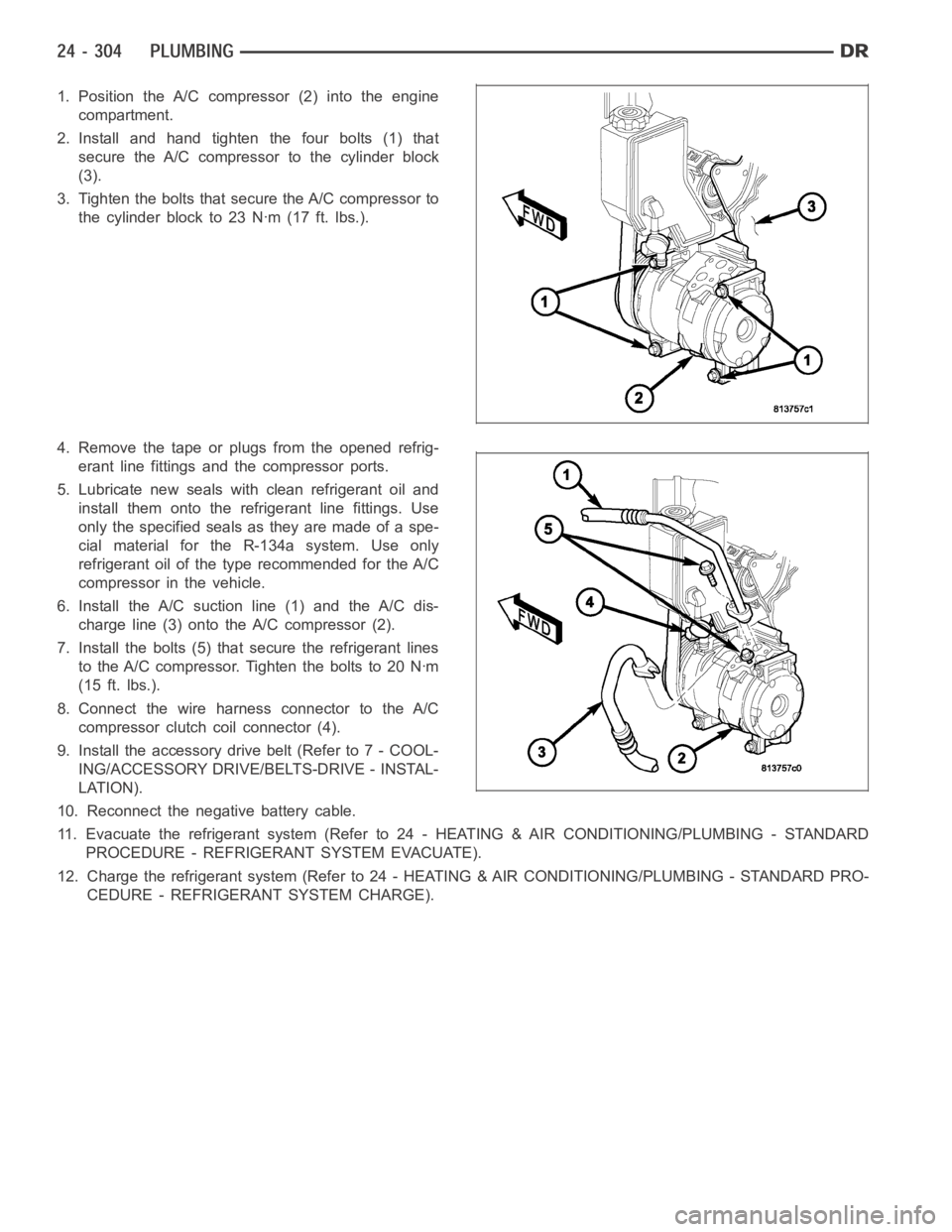
1. Position the A/C compressor (2) into the engine
compartment.
2. Install and hand tighten the four bolts (1) that
secure the A/C compressor to the cylinder block
(3).
3. Tighten the bolts that secure the A/C compressor to
the cylinder block to 23 Nꞏm (17 ft. lbs.).
4. Remove the tape or plugs from the opened refrig-
erant line fittings and the compressor ports.
5. Lubricate new seals with clean refrigerant oil and
install them onto the refrigerant line fittings. Use
only the specified seals as they are made of a spe-
cial material for the R-134a system. Use only
refrigerant oil of the type recommended for the A/C
compressor in the vehicle.
6. Install the A/C suction line (1) and the A/C dis-
charge line (3) onto the A/C compressor (2).
7. Install the bolts (5) that secure the refrigerant lines
to the A/C compressor. Tighten the bolts to 20 Nꞏm
(15 ft. lbs.).
8. Connect the wire harness connector to the A/C
compressor clutch coil connector (4).
9. Install the accessory drive belt (Refer to 7 - COOL-
ING/ACCESSORY DRIVE/BELTS-DRIVE - INSTAL-
LATION).
10. Reconnect the negative battery cable.
11. Evacuate the refrigerant system (Refer to 24 - HEATING & AIR CONDITIONING/PLUMBING - STANDARD
PROCEDURE - REFRIGERANT SYSTEM EVACUATE).
12. Charge the refrigerant system (Refer to 24 - HEATING & AIR CONDITIONING/PLUMBING - STANDARD PRO-
CEDURE - REFRIGERANT SYSTEM CHARGE).
Page 5155 of 5267

COUPLER-REFRIGERANT LINE
DESCRIPTION
Spring-lock type refrigerant line couplers (1 and 4) are
used to connect the A/C suction line (6) to the A/C
accumulator (5) and, the A/C accumulator and the A/C
liquid line to the A/C evaporator tubes (3). Secondary
retaining clips (2 and 7) are installed over the con-
nected couplers for added protection.
The spring-lock refrigerant line couplers require spe-
cial disconnect tools for disengaging the two coupler
halves.
OPERATION
The spring-lock type refrigerant line coupler is held
together by a garter spring (6) inside a circular cage
(7) on the male half of the fitting (1). When the two
coupler halves are connected, the flared end of the
female fitting (2) slips behind the garter spring inside
the cage on the male fitting. The garter spring and
cage prevent the flared end of the female fitting from
pulling out of the cage. Some applications use a con-
nection indicator ring (4) to help indicate when the two
coupler halves are fully connected.
Two O-rings (8) are used to seal the coupler connec-
tions. These O-rings are compatible with R-134a
refrigerant and must be replaced with O-rings made of
the same material.
A secondary retaining clip (3) is installed over the con-
nected coupler (5) for added protection.
REMOVAL
WARNING: Refer to the applicable warnings and cautions for this system before performing the following
operation (Refer to 24 - HEATING & AIR CONDITIONING/PLUMBING - WARNINGS) and (Refer to 24 - HEAT-
ING & AIR CONDITIONING/PLUMBING - CAUTIONS). Failure to follow the warnings and cautions could result
in possible personal injury or death.
Page 5156 of 5267
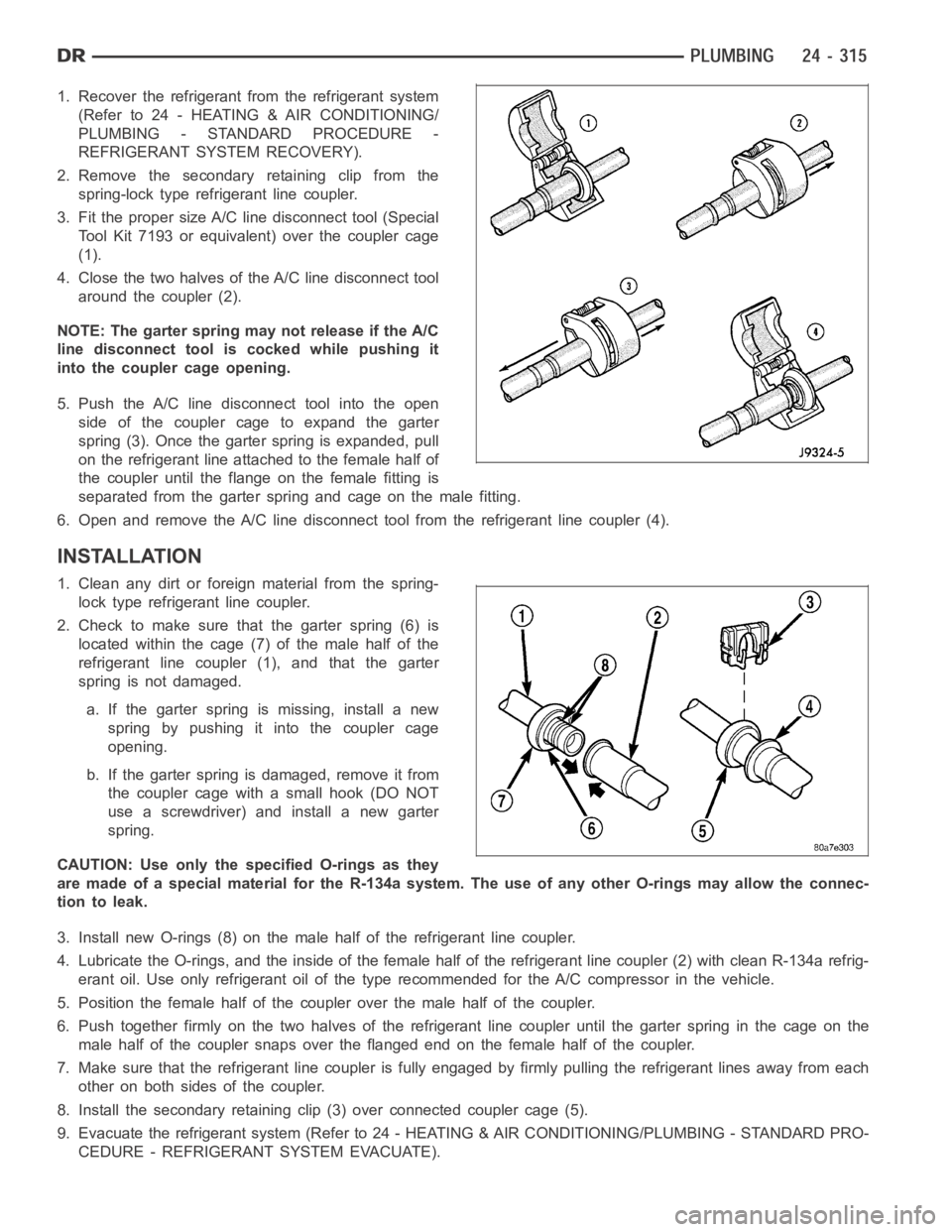
1. Recover the refrigerant from the refrigerant system
(Refer to 24 - HEATING & AIR CONDITIONING/
PLUMBING - STANDARD PROCEDURE -
REFRIGERANT SYSTEM RECOVERY).
2. Remove the secondary retaining clip from the
spring-lock type refrigerant line coupler.
3. Fit the proper size A/C line disconnect tool (Special
Tool Kit 7193 or equivalent) over the coupler cage
(1).
4. Close the two halves of the A/C line disconnect tool
around the coupler (2).
NOTE: The garter spring may not release if the A/C
line disconnect tool is cocked while pushing it
into the coupler cage opening.
5. Push the A/C line disconnect tool into the open
side of the coupler cage to expand the garter
spring (3). Once the garter spring is expanded, pull
on the refrigerant line attached to the female half of
the coupler until the flange on the female fitting is
separated from the garter spring and cage on the male fitting.
6. Open and remove the A/C line disconnect tool from the refrigerant line coupler (4).
INSTALLATION
1. Clean any dirt or foreign material from the spring-
lock type refrigerant line coupler.
2. Check to make sure that the garter spring (6) is
located within the cage (7) of the male half of the
refrigerant line coupler (1), and that the garter
spring is not damaged.
a. If the garter spring is missing, install a new
spring by pushing it into the coupler cage
opening.
b. If the garter spring is damaged, remove it from
the coupler cage with a small hook (DO NOT
use a screwdriver) and install a new garter
spring.
CAUTION: Use only the specified O-rings as they
are made of a special material for the R-134a system. The use of any other O-rings may allow the connec-
tion to leak.
3. Install new O-rings (8) on the male half of the refrigerant line coupler.
4. Lubricate the O-rings, and the inside of the female half of the refrigerant line coupler (2) with clean R-134a refrig-
erant oil. Use only refrigerant oil of the type recommended for the A/C compressor in the vehicle.
5. Position the female half of the coupler over the male half of the coupler.
6. Push together firmly on the two halves of the refrigerant line coupler until the garter spring in the cage on the
male half of the coupler snaps over the flanged end on the female half of the coupler.
7. Make sure that the refrigerant line coupler is fully engaged by firmly pulling the refrigerant lines away from each
other on both sides of the coupler.
8. Install the secondary retaining clip (3) over connected coupler cage (5).
9. Evacuate the refrigerant system (Refer to 24 - HEATING & AIR CONDITIONING/PLUMBING - STANDARD PRO-
CEDURE - REFRIGERANT SYSTEM EVACUATE).
Page 5158 of 5267
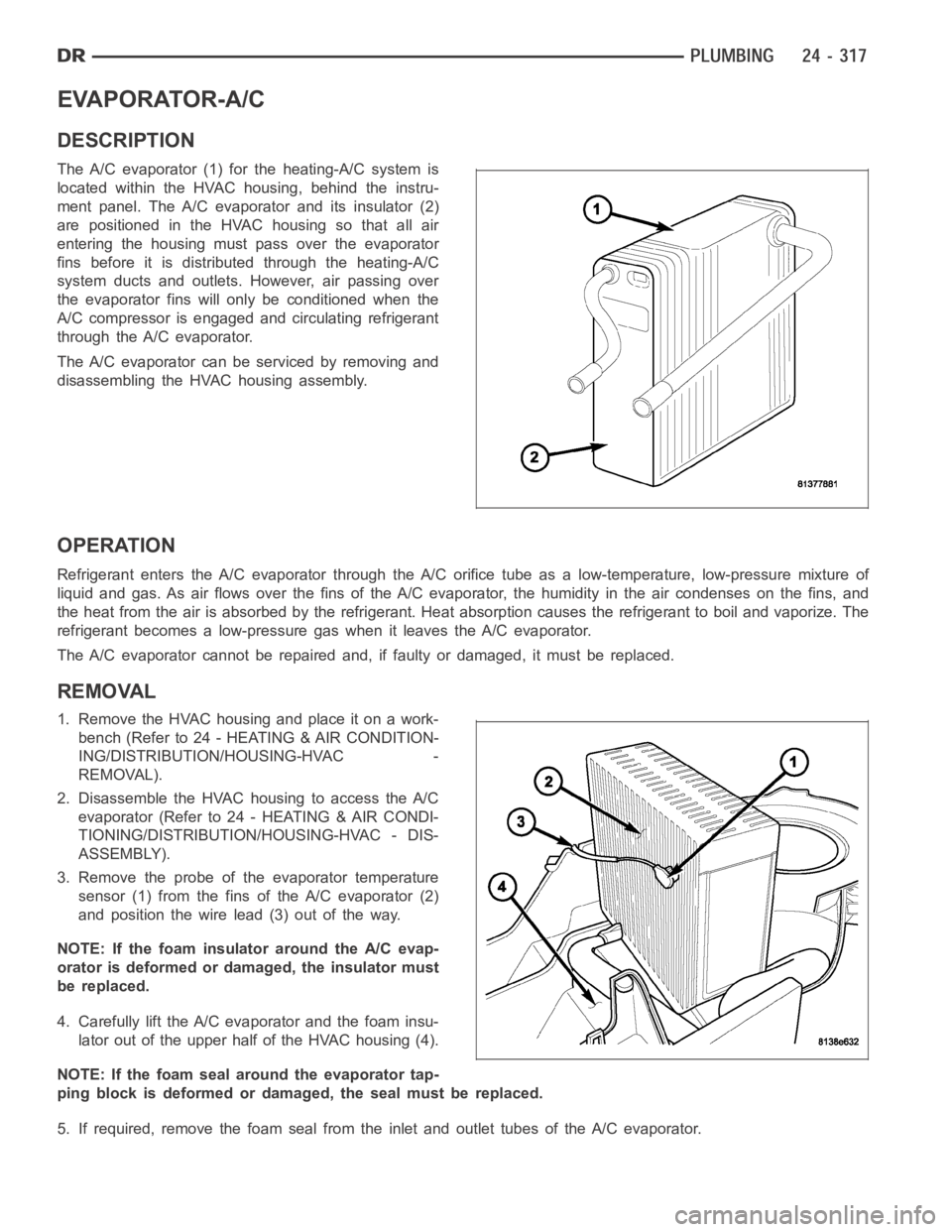
EVAPORATOR-A/C
DESCRIPTION
The A/C evaporator (1) for the heating-A/C system is
located within the HVAC housing, behind the instru-
ment panel. The A/C evaporator and its insulator (2)
are positioned in the HVAC housing so that all air
entering the housing must pass over the evaporator
fins before it is distributed through the heating-A/C
system ducts and outlets. However, air passing over
the evaporator fins will only be conditioned when the
A/C compressor is engaged and circulating refrigerant
through the A/C evaporator.
The A/C evaporator can be serviced by removing and
disassembling the HVAC housing assembly.
OPERATION
Refrigerant enters the A/C evaporator through the A/C orifice tube as a low-temperature, low-pressure mixture of
liquid and gas. As air flows over the fins of the A/C evaporator, the humidity in the air condenses on the fins, and
the heat from the air is absorbed by the refrigerant. Heat absorption causes the refrigerant to boil and vaporize. The
refrigerant becomes a low-pressure gas when it leaves the A/C evaporator.
The A/C evaporator cannot be repaired and, if faulty or damaged, it must be replaced.
REMOVAL
1. RemovetheHVAChousingandplaceitonawork-
bench (Refer to 24 - HEATING & AIR CONDITION-
ING/DISTRIBUTION/HOUSING-HVAC -
REMOVAL).
2. Disassemble the HVAC housing to access the A/C
evaporator (Refer to 24 - HEATING & AIR CONDI-
TIONING/DISTRIBUTION/HOUSING-HVAC - DIS-
ASSEMBLY).
3. Remove the probe of the evaporator temperature
sensor (1) from the fins of the A/C evaporator (2)
and position the wire lead (3) out of the way.
NOTE: If the foam insulator around the A/C evap-
orator is deformed or damaged, the insulator must
be replaced.
4. Carefully lift the A/C evaporator and the foam insu-
lator out of the upper half of the HVAC housing (4).
NOTE: If the foam seal around the evaporator tap-
ping block is deformed or damaged, the seal must be replaced.
5. If required, remove the foam seal from the inlet and outlet tubes of the A/Cevaporator.
Page 5164 of 5267
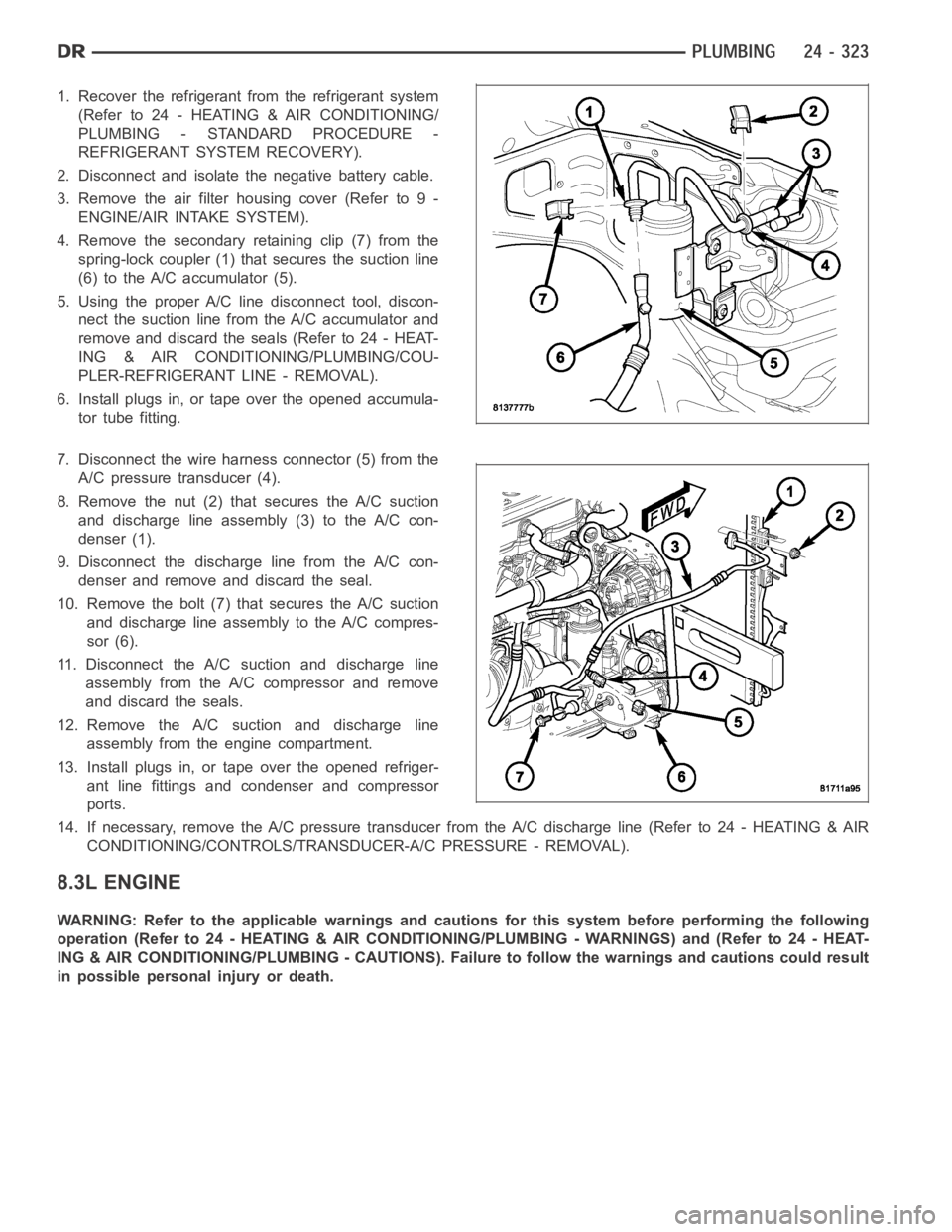
1. Recover the refrigerant from the refrigerant system
(Refer to 24 - HEATING & AIR CONDITIONING/
PLUMBING - STANDARD PROCEDURE -
REFRIGERANT SYSTEM RECOVERY).
2. Disconnect and isolate the negative battery cable.
3. Remove the air filter housing cover (Refer to 9 -
ENGINE/AIR INTAKE SYSTEM).
4. Remove the secondary retaining clip (7) from the
spring-lock coupler (1) thatsecures the suction line
(6) to the A/C accumulator (5).
5. Using the proper A/C line disconnect tool, discon-
nect the suction line from the A/C accumulator and
remove and discard the seals (Refer to 24 - HEAT-
ING & AIR CONDITIONING/PLUMBING/COU-
PLER-REFRIGERANT LINE - REMOVAL).
6. Install plugs in, or tape over the opened accumula-
tor tube fitting.
7. Disconnect the wire harness connector (5) from the
A/C pressure transducer (4).
8. Remove the nut (2) that secures the A/C suction
and discharge line assembly (3) to the A/C con-
denser (1).
9. Disconnect the discharge line from the A/C con-
denser and remove and discard the seal.
10. Remove the bolt (7) that secures the A/C suction
and discharge line assembly to the A/C compres-
sor (6).
11. Disconnect the A/C suction and discharge line
assembly from the A/C compressor and remove
and discard the seals.
12. Remove the A/C suction and discharge line
assembly from the engine compartment.
13. Install plugs in, or tape over the opened refriger-
ant line fittings and condenser and compressor
ports.
14. If necessary, remove the A/C pressure transducer from the A/C dischargeline(Referto24-HEATING&AIR
CONDITIONING/CONTROLS/TRANSDUCER-A/C PRESSURE - REMOVAL).
8.3L ENGINE
WARNING: Refer to the applicable warnings and cautions for this system before performing the following
operation (Refer to 24 - HEATING & AIR CONDITIONING/PLUMBING - WARNINGS) and (Refer to 24 - HEAT-
ING & AIR CONDITIONING/PLUMBING - CAUTIONS). Failure to follow the warnings and cautions could result
in possible personal injury or death.
Page 5168 of 5267
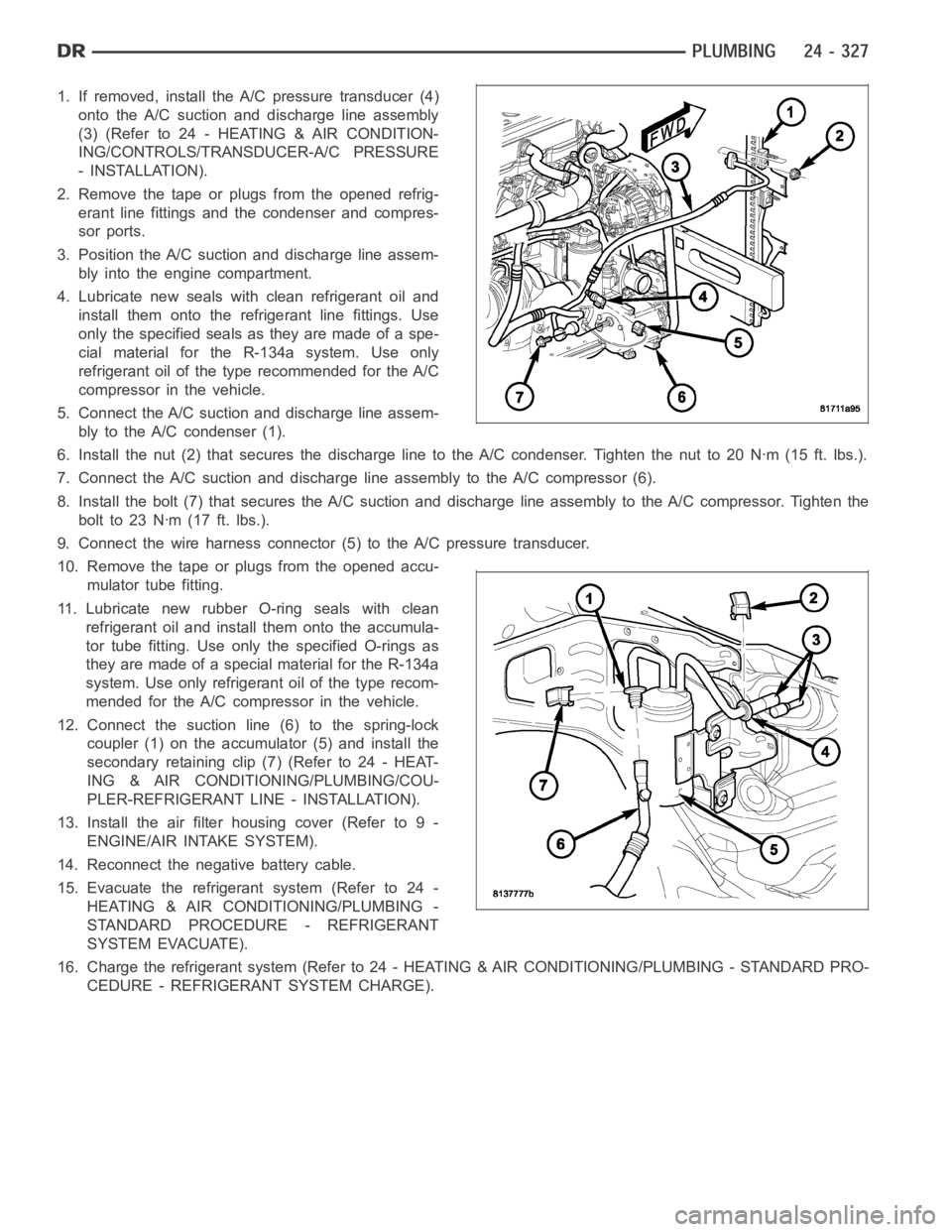
1. If removed, install the A/C pressure transducer (4)
onto the A/C suction and discharge line assembly
(3)(Referto24-HEATING&AIRCONDITION-
ING/CONTROLS/TRANSDUCER-A/C PRESSURE
- INSTALLATION).
2. Remove the tape or plugs from the opened refrig-
erant line fittings and the condenser and compres-
sor ports.
3. Position the A/C suction and discharge line assem-
bly into the engine compartment.
4. Lubricate new seals with clean refrigerant oil and
install them onto the refrigerant line fittings. Use
only the specified seals as they are made of a spe-
cial material for the R-134a system. Use only
refrigerant oil of the type recommended for the A/C
compressor in the vehicle.
5. Connect the A/C suction and discharge line assem-
bly to the A/C condenser (1).
6. Install the nut (2) that secures the discharge line to the A/C condenser.Tighten the nut to 20 Nꞏm (15 ft. lbs.).
7. Connect the A/C suction and discharge line assembly to the A/C compressor(6).
8. Install the bolt (7) that secures the A/C suction and discharge line assembly to the A/C compressor. Tighten the
boltto23Nꞏm(17ft.lbs.).
9. Connect the wire harness connector (5) to the A/C pressure transducer.
10. Remove the tape or plugs from the opened accu-
mulator tube fitting.
11. Lubricate new rubber O-ring seals with clean
refrigerant oil and install them onto the accumula-
tor tube fitting. Use only the specified O-rings as
they are made of a special material for the R-134a
system. Use only refrigerant oil of the type recom-
mended for the A/C compressor in the vehicle.
12. Connect the suction line (6) to the spring-lock
coupler (1) on the accumulator (5) and install the
secondary retaining clip (7) (Refer to 24 - HEAT-
ING & AIR CONDITIONING/PLUMBING/COU-
PLER-REFRIGERANT LINE - INSTALLATION).
13. Install the air filter housing cover (Refer to 9 -
ENGINE/AIR INTAKE SYSTEM).
14. Reconnect the negative battery cable.
15. Evacuate the refrigerant system (Refer to 24 -
HEATING & AIR CONDITIONING/PLUMBING -
STANDARD PROCEDURE - REFRIGERANT
SYSTEM EVACUATE).
16. Charge the refrigerant system (Refer to 24 - HEATING & AIR CONDITIONING/PLUMBING - STANDARD PRO-
CEDURE - REFRIGERANT SYSTEM CHARGE).
Page 5171 of 5267
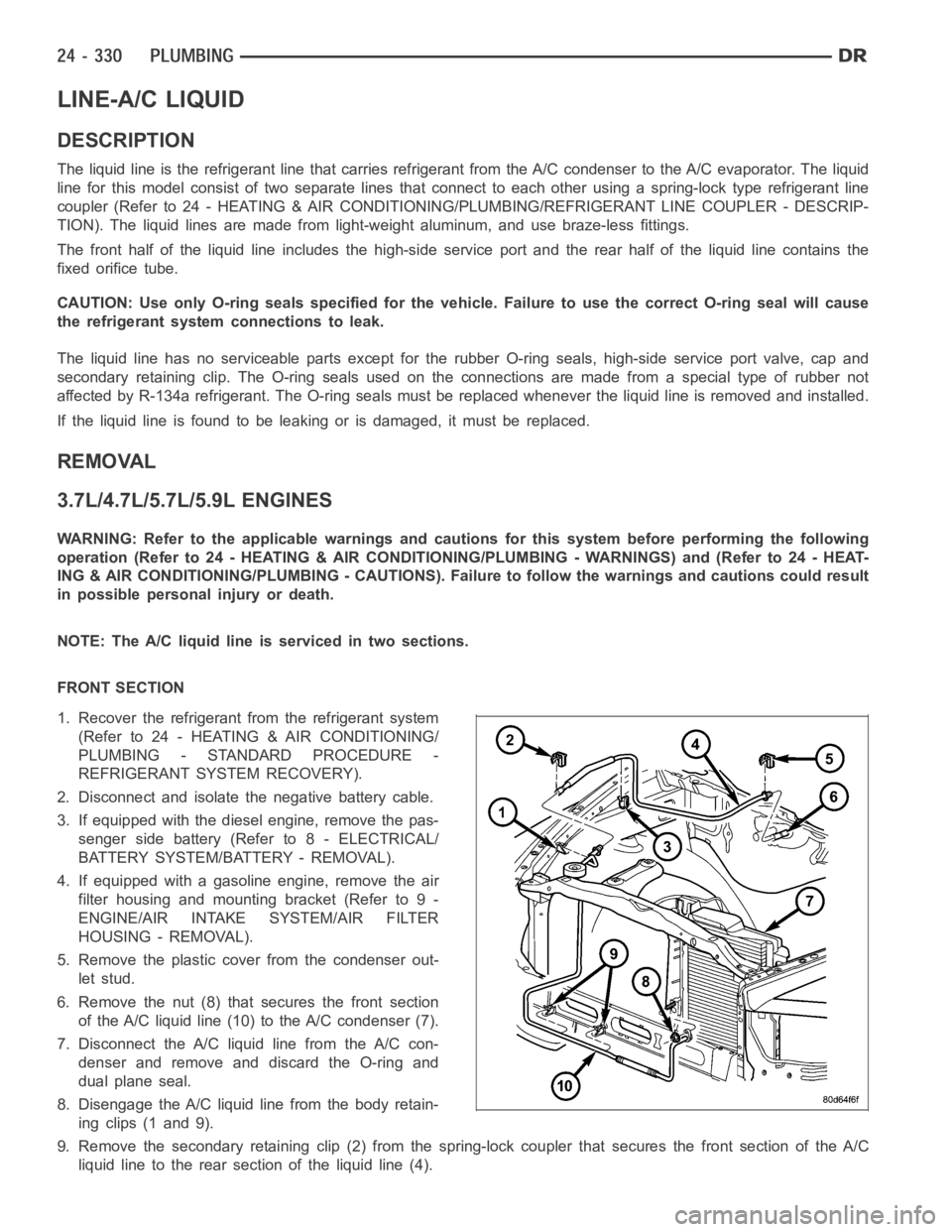
LINE-A/C LIQUID
DESCRIPTION
The liquid line is the refrigerant line that carries refrigerant from the A/C condenser to the A/C evaporator. The liquid
line for this model consist of two separate lines that connect to each otherusing a spring-lock type refrigerant line
coupler (Refer to 24 - HEATING & AIR CONDITIONING/PLUMBING/REFRIGERANT LINE COUPLER - DESCRIP-
TION). The liquid lines are made from light-weight aluminum, and use braze-less fittings.
The front half of the liquid line includes the high-side service port and the rear half of the liquid line contains the
fixed orifice tube.
CAUTION: Use only O-ring seals specified for the vehicle. Failure to use the correct O-ring seal will cause
the refrigerant system connections to leak.
The liquid line has no serviceable parts except for the rubber O-ring seals, high-side service port valve, cap and
secondary retaining clip. The O-ring seals used on the connections are made from a special type of rubber not
affected by R-134a refrigerant. The O-ring seals must be replaced whenever the liquid line is removed and installed.
If the liquid line is found to be leaking or is damaged, it must be replaced.
REMOVAL
3.7L/4.7L/5.7L/5.9L ENGINES
WARNING: Refer to the applicable warnings and cautions for this system before performing the following
operation (Refer to 24 - HEATING & AIR CONDITIONING/PLUMBING - WARNINGS) and (Refer to 24 - HEAT-
ING & AIR CONDITIONING/PLUMBING - CAUTIONS). Failure to follow the warnings and cautions could result
in possible personal injury or death.
NOTE:TheA/Cliquidlineisservicedintwosections.
FRONT SECTION
1. Recover the refrigerant from the refrigerant system
(Refer to 24 - HEATING & AIR CONDITIONING/
PLUMBING - STANDARD PROCEDURE -
REFRIGERANT SYSTEM RECOVERY).
2. Disconnect and isolate the negative battery cable.
3. If equipped with the diesel engine, remove the pas-
senger side battery (Refer to 8 - ELECTRICAL/
BATTERY SYSTEM/BATTERY - REMOVAL).
4. If equipped with a gasoline engine, remove the air
filter housing and mounting bracket (Refer to 9 -
ENGINE/AIR INTAKE SYSTEM/AIR FILTER
HOUSING - REMOVAL).
5. Remove the plastic cover from the condenser out-
let stud.
6. Remove the nut (8) that secures the front section
of the A/C liquid line (10) to the A/C condenser (7).
7. Disconnect the A/C liquid line from the A/C con-
denser and remove and discard the O-ring and
dual plane seal.
8. Disengage the A/C liquid line from the body retain-
ing clips (1 and 9).
9. Remove the secondary retaining clip (2) from the spring-lock coupler that secures the front section of the A/C
liquid line to the rear section of the liquid line (4).
Page 5172 of 5267
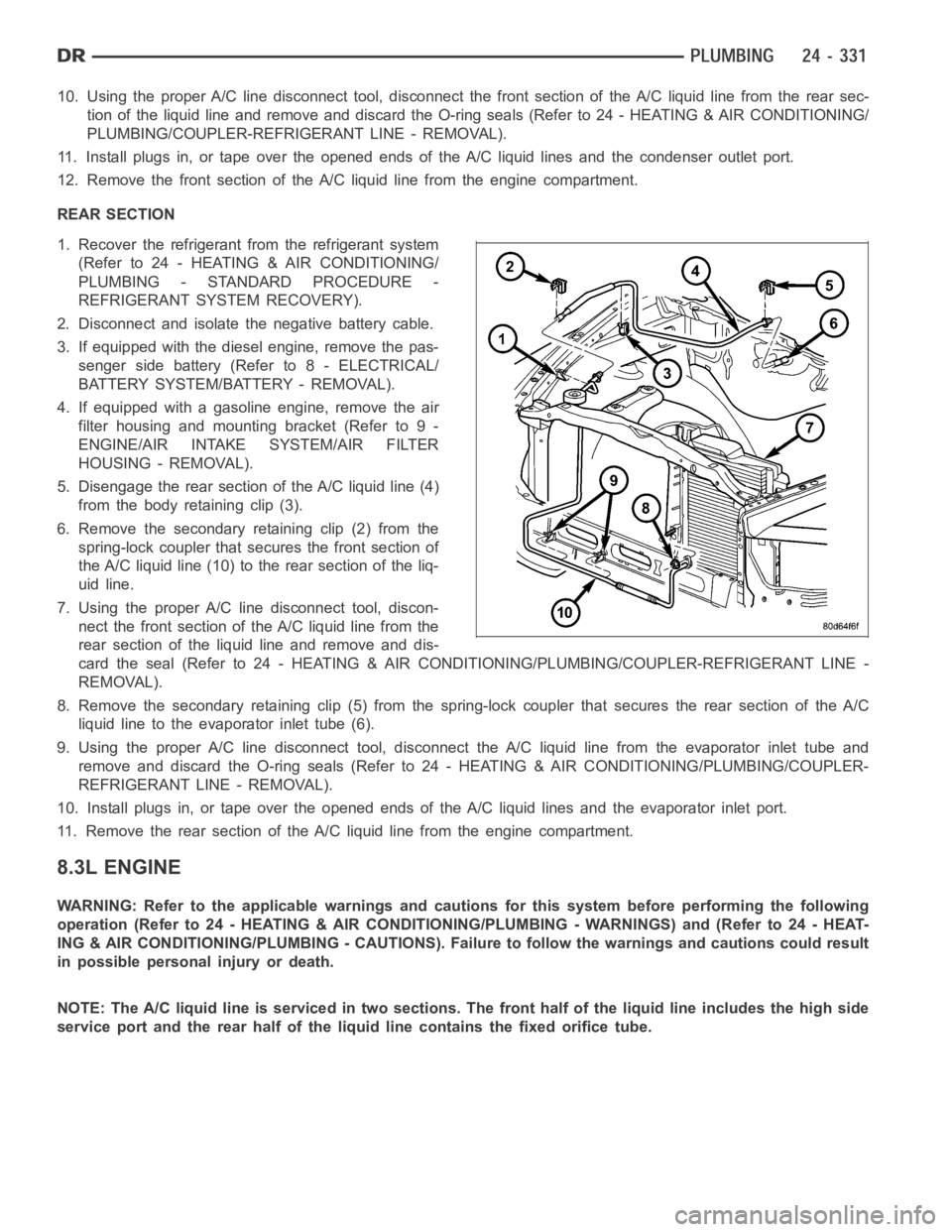
10. Using the proper A/C line disconnect tool, disconnect the front section of the A/C liquid line from the rear sec-
tion of the liquid line and remove and discard the O-ring seals (Refer to 24 -HEATING & AIR CONDITIONING/
PLUMBING/COUPLER-REFRIGERANT LINE - REMOVAL).
11. Install plugs in, or tape over the opened ends of the A/C liquid lines andthe condenser outlet port.
12. Remove the front section of the A/C liquid line from the engine compartment.
REAR SECTION
1. Recover the refrigerant from the refrigerant system
(Refer to 24 - HEATING & AIR CONDITIONING/
PLUMBING - STANDARD PROCEDURE -
REFRIGERANT SYSTEM RECOVERY).
2. Disconnect and isolate the negative battery cable.
3. If equipped with the diesel engine, remove the pas-
senger side battery (Refer to 8 - ELECTRICAL/
BATTERY SYSTEM/BATTERY - REMOVAL).
4. If equipped with a gasoline engine, remove the air
filter housing and mounting bracket (Refer to 9 -
ENGINE/AIR INTAKE SYSTEM/AIR FILTER
HOUSING - REMOVAL).
5. Disengage the rear section of the A/C liquid line (4)
from the body retaining clip (3).
6. Remove the secondary retaining clip (2) from the
spring-lock coupler that secures the front section of
the A/C liquid line (10) to the rear section of the liq-
uid line.
7. Using the proper A/C line disconnect tool, discon-
nect the front section of the A/C liquid line from the
rear section of the liquid line and remove and dis-
card the seal (Refer to 24 - HEATING & AIR CONDITIONING/PLUMBING/COUPLER-REFRIGERANT LINE -
REMOVAL).
8. Remove the secondary retaining clip (5) from the spring-lock coupler that secures the rear section of the A/C
liquid line to the evaporator inlet tube (6).
9. Using the proper A/C line disconnect tool, disconnect the A/C liquid line from the evaporator inlet tube and
removeanddiscardtheO-ringseals(Referto24-HEATING&AIRCONDITIONING/PLUMBING/COUPLER-
REFRIGERANT LINE - REMOVAL).
10. Install plugs in, or tape over the opened ends of the A/C liquid lines andthe evaporator inlet port.
11. Remove the rear section of the A/C liquid line from the engine compartment.
8.3L ENGINE
WARNING: Refer to the applicable warnings and cautions for this system before performing the following
operation (Refer to 24 - HEATING & AIR CONDITIONING/PLUMBING - WARNINGS) and (Refer to 24 - HEAT-
ING & AIR CONDITIONING/PLUMBING - CAUTIONS). Failure to follow the warnings and cautions could result
in possible personal injury or death.
NOTE: The A/C liquid line is serviced in two sections. The front half of the liquid line includes the high side
service port and the rear half of the liquid line contains the fixed orificetube.